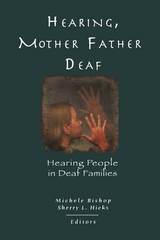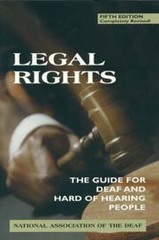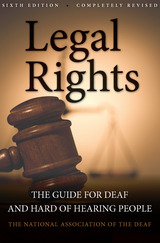3 books about Hearing People

HEARING, MOTHER-FATHER DEAF
Hearing People in Deaf Families
Michele Bishop
Gallaudet University Press, 2009
The 14th Volume in the Sociolinguistics in Deaf Communities Series
The newest entry in the Sociolinguistics in Deaf Communities series explores the richness and complexity of the lives of hearing people in deaf families. Along with their own contributions, volume editors Michele Bishop and Sherry L. Hicks present the work of an extraordinary cadre of deaf, hearing, and Coda (children of deaf adults) researchers: Susan Adams, Jean Andrews, Oya Ataman, Anne E. Baker, Beppie van den Bogaerde , Helsa B. Borinstein, Karen Emmorey, Tamar H. Gollan, Mara Lúcia Masutti, Susan Mather, Ronice Müller de Quadros, Jemina Napier, Paul Preston, Jennie E. Pyers, Robin Thompson, and Andrea Wilhelm. Their findings represent research in a number of countries, including Australia, Brazil, England, Germany, the Netherlands, and the United States.
Hearing, Mother^Father Deaf: Hearing People in Deaf Families includes a comprehensive description of the societal influences at work in the lives of deaf people and their hearing children, which serves as a backdrop for the essays. The topics range from bimodal bilingualism in adults to cultural and linguistic behaviors of hearing children from deaf families; sign and spoken language contact phenomena; and to issues of self-expression, identity, and experience. A blend of data-based research and personal writings, the articles in this sociolinguistic study provide a thorough understanding of the varied experiences of hearing people and their deaf families throughout the world.
The newest entry in the Sociolinguistics in Deaf Communities series explores the richness and complexity of the lives of hearing people in deaf families. Along with their own contributions, volume editors Michele Bishop and Sherry L. Hicks present the work of an extraordinary cadre of deaf, hearing, and Coda (children of deaf adults) researchers: Susan Adams, Jean Andrews, Oya Ataman, Anne E. Baker, Beppie van den Bogaerde , Helsa B. Borinstein, Karen Emmorey, Tamar H. Gollan, Mara Lúcia Masutti, Susan Mather, Ronice Müller de Quadros, Jemina Napier, Paul Preston, Jennie E. Pyers, Robin Thompson, and Andrea Wilhelm. Their findings represent research in a number of countries, including Australia, Brazil, England, Germany, the Netherlands, and the United States.
Hearing, Mother^Father Deaf: Hearing People in Deaf Families includes a comprehensive description of the societal influences at work in the lives of deaf people and their hearing children, which serves as a backdrop for the essays. The topics range from bimodal bilingualism in adults to cultural and linguistic behaviors of hearing children from deaf families; sign and spoken language contact phenomena; and to issues of self-expression, identity, and experience. A blend of data-based research and personal writings, the articles in this sociolinguistic study provide a thorough understanding of the varied experiences of hearing people and their deaf families throughout the world.
[more]

Legal Rights, 5th Ed.
The Guide for Deaf and Hard of Hearing People
National Association of the Deaf
Gallaudet University Press, 2000
"An essential volume for all concerned with the legal rights and services for people with hearing loss."
-- SHHH Journal
"A good guide for compliance with ADA and provides specific suggestions and recommendations."
-- Hearing Rehabilitation Quarterly
The new, revised, fifth edition of Legal Rights offers in easy-to-understand language the latest state and federal statutes and administrative procedures that prohibit discrimination against deaf and hard of hearing people, and any others with physical challenges. It includes complete information on the Telecommunications Act of 1996, new laws for hearing-aid-compatible telephones, the new Rehabilitation Act regulations that ensure access to electronic and information technology, and how recent Supreme Court rulings will affect people who wear hearing aids.
This outstanding resource also explains new requirements for federal buildings and other new structures to provide full access. Recent additions to the Individuals with Disabilities Education Act are described, as are the ways public schools can meet new acoustical standards for classrooms. Legal Rights covers the entire spectrum of communication issues for deaf and hard of hearing people, from the new rules about interpreters in federal courts to the latest developments regarding relay services. It also lists those states that are leaders in ensuring access and equal rights to people with disabilities, making it the most complete source of legal information for deaf and hard of hearing people now available.
Founded in 1880, the National Association of the Deaf (NAD) is the oldest and largest organization representing people with disabilities in the United States.
[more]

Legal Rights, 6th Ed.
The Guide for Deaf and Hard of Hearing People
National Association of the Deaf
Gallaudet University Press, 2015
The standard handbook on law affecting deaf and hard of hearing people has been completely rewritten and updated. The sixth edition of Legal Rights: The Guide for Deaf and Hard of Hearing People meticulously describes those statutes that prohibit discrimination against deaf and hard of hearing people, and any others with physical challenges. Written in easy-to-understand language, the new edition describes the core legislation and laws and their critical importance since their inception: The Rehabilitation Act of 1973, the Individuals with Disabilities Education Act (IDEA), and the Americans with Disabilities Act (ADA).
The new Legal Rights also explains the significant amendments to these laws, including the ADA Amendments Act (ADAAA) and new regulations to its Title II concerning public entities and Title III pertaining to public accommodations and commercial facilities. The reauthorization of IDEA expanded the No Child Left Behind Act requirement for highly qualified teachers to all students with disabilities. This new edition also tracks the trend of passing a Deaf and Hard of Hearing Children’s Bill of Rights in a growing number of state legislatures.
This completely new resource also delineates new legislation such as the Twenty-First Century Communications Video and Accessibility Act, which ensures access to the newest communications technology for deaf and hard of hearing people. Legal Rights also includes information on the use of interpreters in the legal system, securing its position as the most comprehensive reference of legal information for deaf and hard of hearing people now available.
The new Legal Rights also explains the significant amendments to these laws, including the ADA Amendments Act (ADAAA) and new regulations to its Title II concerning public entities and Title III pertaining to public accommodations and commercial facilities. The reauthorization of IDEA expanded the No Child Left Behind Act requirement for highly qualified teachers to all students with disabilities. This new edition also tracks the trend of passing a Deaf and Hard of Hearing Children’s Bill of Rights in a growing number of state legislatures.
This completely new resource also delineates new legislation such as the Twenty-First Century Communications Video and Accessibility Act, which ensures access to the newest communications technology for deaf and hard of hearing people. Legal Rights also includes information on the use of interpreters in the legal system, securing its position as the most comprehensive reference of legal information for deaf and hard of hearing people now available.
[more]
READERS
Browse our collection.
PUBLISHERS
See BiblioVault's publisher services.
STUDENT SERVICES
Files for college accessibility offices.
UChicago Accessibility Resources
home | accessibility | search | about | contact us
BiblioVault ® 2001 - 2024
The University of Chicago Press









